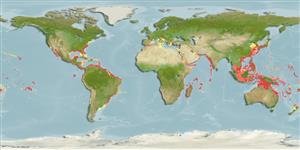Common names from other countries
Classification / Names / Names
Common names | Synonyms | Catalog of Fishes (gen., sp.) | ITIS | CoL | WoRMS
Environment: milieu / climate zone / depth range / distribution range
Ecology
Benthic; depth range 0 - 100 m (Ref. 1840). Subtropical
Western Central Atlantic, Indo-Pacific and the Mediterranean Sea.
Length at first maturity / Size / Weight / Age
Maturity: Lm ? range ? - ? cm
Benthic (Ref. 85346). Sand-dwelling species found at intertidal depths to 100 m (Ref. 1840, page 197). Sipunculans are nonselective suspension or deposit feeders (Ref. 833).
Pancucci-papadopoulou, M.A., G.V.V. Murina and A. Zenetos. 1999. (Ref. 1872)
IUCN Red List Status (Ref. 130435)
CITES status (Ref. 108899)
Not Evaluated
Not Evaluated
Human uses
| FishSource |
Tools
More information
Common namesSynonymsPredatorsReproductionMaturitySpawningFecundityEggsEgg development
Age/SizeGrowthLength-weightLength-lengthMorphologyLarvaeAbundance
Internet sources
Estimates based on models
Preferred temperature
(Ref.
115969): 21.5 - 29, mean 27.3 (based on 2374 cells).
Price category
Unknown.
